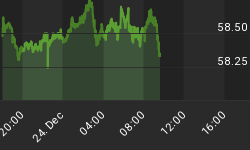This week’s stock market volatility is all about interest rate fears and market participants’ knee-jerk reactions to Fed comments before they’ve had time to digest the details.
By the time the market closed on Tuesday, stocks were reeling from new Fed Jerome Powell’s comments, which at first appeared to be interpreted in a hawkish manner and then descended into fear of a more aggressive policy of interest rate hikes. The Dow lost almost 300 points.
This is what the close on Tuesday looked like:

(Click to enlarge)
On 5 February, already building up anxiety-ridden expectations of Powell first appearance on Capitol Hill, the Dow had lost 1,175 points—the most it’s ever lost in a single trading day. It only came mildly close to losing this much in September 2008, in the throes of a financial crisis, when it lost 778 points.
Then we saw a three-day winning streak on the Dow and everyone thought the correction was over. But it wasn’t. As we got closer again to Powell’s debut, the jitters returned, resulting in Tuesday’s disappointment.
But then in early trading Wednesday, the Dow had regained 100 points.
So, is the correction over … or not? That’s the million-dollar question, of course.
It’s been a month for corrections across the board, and that’s sparked fears that the 9-year bull run is definitively over.
The market is on edge over interest rates and inflation. And just like the tiniest of whispers from OPEC has been able to send oil up or down regardless of fundamentals over the past few years, trying to interpret or reinterpret what the Fed is saying does the same.
Indeed, a day of just sitting and waiting and trying to guess what the Fed might say the next day can result what we saw on Monday. Related: New Fed Chair Upbeat On U.S. Economy
So, if market participants were so worried about interest rates and inflation on Monday and Tuesday, why has the panic seemingly subsided on Wednesday—so far?
It’s another million-dollar question whose answer lies in the realm of psychology.
What we do know is this: On Tuesday, the market was responding largely to Powell’s comments on interest rate hikes that seemed to suggest there may be more than three.
More specifically, it was this comment that put everyone on edge:
"At the December meeting, the median [FOMC] participant called for three rate increases in 2018. Now since then -- and we will submit another projection, all of us, in three weeks -- but what we've seen is incoming data that suggests a strengthening in the economy," Powell said Tuesday in his testimony.
Then, on Wednesday morning, a sudden change of heart. Why? Quite simply, because investors need time to digest all the data. After letting inflation and interest rate hike fears guide market participation on Monday and Tuesday, now they’re examining some of the details.
Market participants are impatient. They respond to the bold letters first and then correct with granular details.
Among those correcting details was a closer look, overnight, at fourth-quarter GDP growth figures, which came in at 2.5 percent. Initial estimates were 2.6 percent. That’s much slower than third-quarter growth of 3.2 percent.
Market participants fear this kind of growth because it prompts the Fed to try to put a leash on inflation with more interest rate hikes. Now that they have a slightly better handle on the growth picture, and it looks like its slowing a bit, the stock market is back in favor.
Is the correction over, then? That depends on the momentary whims of its players. Any more whispers of more rate hikes will set back correction recovery again.
By Charles Benavidez for Safehaven.com
More Top Reads From Safehaven.com:
















